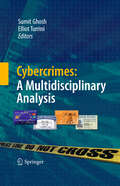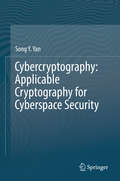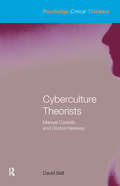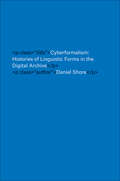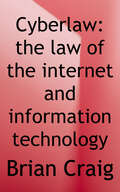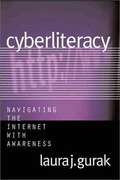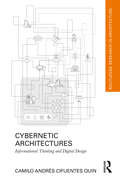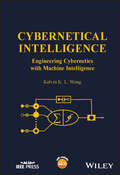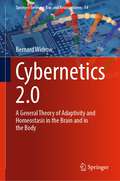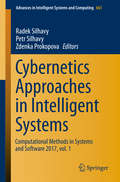- Table View
- List View
Cybercrimes: A Multidisciplinary Analysis
by Sumit Ghosh Elliot TurriniDesigned to serve as a reference work for practitioners, academics, and scholars worldwide, this book is the first of its kind to explain complex cybercrimes from the perspectives of multiple disciplines (computer science, law, economics, psychology, etc.) and scientifically analyze their impact on individuals, society, and nations holistically and comprehensively. In particular, the book shows: How multiple disciplines concurrently bring out the complex, subtle, and elusive nature of cybercrimes How cybercrimes will affect every human endeavor, at the level of individuals, societies, and nations How to legislate proactive cyberlaws, building on a fundamental grasp of computers and networking, and stop reacting to every new cyberattack How conventional laws and traditional thinking fall short in protecting us from cybercrimes How we may be able to transform the destructive potential of cybercrimes into amazing innovations in cyberspace that can lead to explosive technological growth and prosperity
Cybercryptography: Applicable Cryptography for Cyberspace Security
by Song Y. YanThis book provides the basic theory, techniques, and algorithms of modern cryptography that are applicable to network and cyberspace security. It consists of the following nine main chapters: Chapter 1 provides the basic concepts and ideas of cyberspace and cyberspace security, Chapters 2 and 3 provide an introduction to mathematical and computational preliminaries, respectively. Chapters 4 discusses the basic ideas and system of secret-key cryptography, whereas Chapters 5, 6, and 7 discuss the basic ideas and systems of public-key cryptography based on integer factorization, discrete logarithms, and elliptic curves, respectively. Quantum-safe cryptography is presented in Chapter 8 and offensive cryptography, particularly cryptovirology, is covered in Chapter 9. This book can be used as a secondary text for final-year undergraduate students and first-year postgraduate students for courses in Computer, Network, and Cyberspace Security. Researchers and practitioners working in cyberspace security and network security will also find this book useful as a reference.
Cyberculture Theorists: Manuel Castells and Donna Haraway (Routledge Critical Thinkers)
by David BellThis book surveys a ‘cluster’ of works that seek to explore the cultures of cyberspace, the Internet and the information society. It introduces key ideas, and includes detailed discussion of the work of two key thinkers in this area, Manuel Castells and Donna Haraway, as well as outlining the development of cyberculture studies as a field. To do this, the book also explores selected ‘moments’ in this development, from the early 1990s, when cyberspace and cyberculture were only just beginning to come together as ideas, up to the present day, when the field of cyberculture studies has grown and bloomed, producing innovative theoretical and empirical work from a diversity of standpoints. Key topics include: life on the screen network society space of flows cyborg methods. Cyberculture Theorists is the ideal starting point for anyone wanting to understand how to theorise cyberculture in all its myriad forms.
Cyberdanger: Understanding and Guarding Against Cybercrime
by Eddy WillemsThis book describes the key cybercrime threats facing individuals, businesses, and organizations in our online world. The author first explains malware and its origins; he describes the extensive underground economy and the various attacks that cybercriminals have developed, including malware, spam, and hacking; he offers constructive advice on countermeasures for individuals and organizations; and he discusses the related topics of cyberespionage, cyberwarfare, hacktivism, and anti-malware organizations, and appropriate roles for the state and the media. The author has worked in the security industry for decades, and he brings a wealth of experience and expertise. In particular he offers insights about the human factor, the people involved on both sides and their styles and motivations. He writes in an accessible, often humorous way about real-world cases in industry, and his collaborations with police and government agencies worldwide, and the text features interviews with leading industry experts. The book is important reading for all professionals engaged with securing information, people, and enterprises. It’s also a valuable introduction for the general reader who wants to learn about cybersecurity.
Cyberdefense: The Next Generation (International Series in Operations Research & Management Science #342)
by Marcus Matthias KeuppThis book analyzes cyberdefense from a novel and interdisciplinary perspective, offering solutions for problems that have long impeded a more efficient defense. It explains why cyberdefense organized and performed by humans is too slow, too cumbersome, and too ineffective. Combining the analytical capabilities of experts in operations research and management, international security studies, economics, risk analysis, and defense management, the volume addresses these problems of current cyberdefense. The authors present suggestions for the next generation of cyberdefense, explaining why the future defense must focus on speeding up responses, why a single response may not be enough, and why effectiveness requires foresight.This makes the book a must-read for scholars, researchers, intelligence analysts, homeland security staff, and professionals who are interested in learning more about the issues of current cyberdefense, as well as solutions for the next generation of cyberdefense.
Cyberdeterrence and Cyberwar
by Martin C. LibickiCyberspace, where information--and hence serious value--is stored and manipulated, is a tempting target. An attacker could be a person, group, or state and may disrupt or corrupt the systems from which cyberspace is built. When states are involved, it is tempting to compare fights to warfare, but there are important differences. The author addresses these differences and ways the United States protect itself in the face of attack.
Cyberdipendenza
by Juan Moisés de la Serna Sara CaceffoLa tecnologia è ogni giorno più presente nelle nostre vite. Questo comporta un evidente progresso, ma anche un pericolo, specialmente fra i più giovani, che possono cadere nella cosiddetta cyberdipendenza . Questa si è convertita in una realtà del giorno d'oggi, un problema di salute che non esisteva affatto appena una decina di anni fa, e che ogni giorno provoca nuove vittime, sempre più giovani. Sebbene le conseguenze a lungo termine siano ancora sconosciute, alcuni studi rivelano che il fenomeno riguarda un 30% dei giovani che usano Internet quotidianamente, presupponendo così che un giovane su tre sia a rischio di sviluppare una dipendenza di tipo comportamentale. Nonostante alcuni paesi stiano iniziando ad adottare misure per prevenire il problema, altri ancora non percepiscono la gravità della situazione, di qui segue la necessità di divulgare i risultati delle ultime indagini in tema e dare visibilità a un problema sociale che richiede misure tanto preventive quanto terapeutiche.
Cyberemotions: Collective Emotions in Cyberspace (Understanding Complex Systems)
by Janusz A. HolystThis is the first monograph of its kind introduces the reader to fundamental definitions, key concepts and case studies addressing the following *What are emotions? How do they emerge, and how are *How can we *What are *When do emotions and *How can we model emotions and their changes? *What role do emotions play in online Edited and authored by leading scientists in the field, this book serves as an introduction and reference resource for researchers working on applications of complex systems methods in the social sciences, as well for social scientists, psychologists, online-community experts and computer scientists. This book provides an excellent overview of the current state-of-art in research on collective emotional interactions mediated by the Internet. This fascinating interdisciplinary research field is shown from perspectives of social scientists, physicists, as well as specialists in data mining and information technology. The book introduces a reader in social phenomena occurring in cyberspace, algorithms needed for automatic sentiment detection and data driven modeling of emotional patterns observed in on-line groups. H. Eugene Stanley, Professor, Boston University We are what we communicate: communicare ergo sum! With the explosive hyper exponential growth of the internet suddenly new ways of communication are emerging that give rise to a digital 'Homo empathicus', each of us suddenly being able to share thoughts and feelings with millions if not billions of others. This book is a true treat, a timely milestone that gives us insight in the co-evolution of the way we interact with each other and the communication technology provided through this new seemingly endless flexible digital world. Prof. Holyst did a great job bringing together real experts in the field of cyber emotions, they give us a reflection of where we come from and, as important, they open up new vistas of where we are going. Peter M. A. Sloot, Professor, University of Amsterdam, the Netherlands, Nanyang University, Singapore The book Cyberemotions embraces the topic of emotion studies in cyberspace from a very rich spectrum of points of view and applications. It is particularly interesting reading the theoretical foundations underlying the concepts of Cyberemotions and how these concepts can be captured, modeled and implemented in real-time applications. Exploring collective emotions in online settings is extremely challenging and opens new directions of research. Catherine Pelachaud, Director of Research CNRS at LTCI, TELECOM ParisTech Logical machines give us a chance to analyze our often illogical behaviors, especially in the vast meadows of the cyberspace. In this important book, authors of different backgrounds present a wide and deep image, not only of methods of analyzing our emotional behavior online but also how the computers can help to break communicational walls the same technology had built. Rafał Rzepka, Professor, Hokkaido University
Cyberfeminism and Artificial Life
by Sarah KemberCyberfeminism and Artificial Life examines the construction, manipulation and re-definition of life in contemporary technoscientific culture. It takes a critical political view of the concept of life as information, tracing this through the new biology and the discourse of genomics as well as through the changing discipline of artificial life and its manifestation in art, language, literature, commerce and entertainment. From cloning to computer games, and incorporating an analysis of hardware, software and 'wetware', Sarah Kember extends current understanding by demonstrating the ways in which this relatively marginal field connects with, and connects up global networks of information systems.Ultimately, this book aims to re-focus concern on the ethics rather than on the 'nature' of life-as-it-could-be.
Cyberformalism: Histories of Linguistic Forms in the Digital Archive
by Daniel ShoreA groundbreaking study of how abstract linguistic signs circulate in literature, intellectual history, and popular culture.Linguistic forms are essential to meaning: like words, they make a semantic contribution to the things we say. We inherit them from past writers and speakers and fill them with different words to produce novel utterances. They shape us and the ways we interpret the world. Yet prevalent assumptions about language and the constraints of print-finding tools have kept linguistic forms and their histories hidden from view. Drawing on recent work in cognitive and construction grammar along with tools and methods developed by corpus and computational linguists, Daniel Shore’s Cyberformalism represents a new way forward for digital humanities scholars seeking to understand the textual past. Championing a qualitative approach to digital archives, Shore uses the abstract pattern-matching capacities of search engines to explore precisely those combinatory aspects of language—word order, syntax, categorization—discarded by the "bag of words" quantitative methods that are dominant in the digital humanities. While scholars across the humanities have long explored the histories of words and phrases, Shore argues that increasingly sophisticated search tools coupled with growing full-text digital archives make it newly possible to study the histories of linguistic forms. In so doing, Shore challenges a range of received metanarratives and complicates some of the most basic concepts of literary study. Touching on canonical works by Shakespeare, Milton, Wordsworth, and Kant, even as it takes the full diversity of digitized texts as its purview, Cyberformalism asks scholars of literature, history, and culture to revise nothing less than their understanding of the linguistic sign.
Cybergefahr: Wie wir uns gegen Cyber-Crime und Online-Terror wehren können
by Eddy WillemsMan kann online wählen, Rechnungen bezahlen und Tickets kaufen - aber wie sicher ist das? Überall lauern Viren, Spam, Hackerangriffe und sogar Cyber-Spione. Wie kann man sich schützen und wie sollte man dem Phänomen Cyber-Crime begegnen? Der bekannte Security-Experte Eddy Willems gibt einen Überblick über Online-Gefahren und Möglichkeiten, sich vor ihnen zu schützen. Er erläutert spannend die Vergangenheit, Gegenwart und Zukunft des Cyber-Crime.
Cyberidentities: Canadian and European Presence in Cyberspace
by Leen D'HaenensThis innovative study explores diverse aspects of Canadian and European identity on the information highway and reaches beyond technical issues to confront and explore communication, culture and the culture of communication.
Cyberinsurance Policy: Rethinking Risk in an Age of Ransomware, Computer Fraud, Data Breaches, and Cyberattacks (Information Policy)
by Josephine WolffWhy cyberinsurance has not improved cybersecurity and what governments can do to make it a more effective tool for cyber risk management.As cybersecurity incidents—ranging from data breaches and denial-of-service attacks to computer fraud and ransomware—become more common, a cyberinsurance industry has emerged to provide coverage for any resulting liability, business interruption, extortion payments, regulatory fines, or repairs. In this book, Josephine Wolff offers the first comprehensive history of cyberinsurance, from the early &“Internet Security Liability&” policies in the late 1990s to the expansive coverage offered today. Drawing on legal records, government reports, cyberinsurance policies, and interviews with regulators and insurers, Wolff finds that cyberinsurance has not improved cybersecurity or reduced cyber risks. Wolff examines the development of cyberinsurance, comparing it to other insurance sectors, including car and flood insurance; explores legal disputes between insurers and policyholders about whether cyber-related losses were covered under policies designed for liability, crime, or property and casualty losses; and traces the trend toward standalone cyberinsurance policies and government efforts to regulate and promote the industry. Cyberinsurance, she argues, is ineffective at curbing cybersecurity losses because it normalizes the payment of online ransoms, whereas the goal of cybersecurity is the opposite—to disincentivize such payments to make ransomware less profitable. An industry built on modeling risk has found itself confronted by new technologies before the risks posed by those technologies can be fully understood.
Cyberjutsu: Cybersecurity for the Modern Ninja
by Ben McCartyLike Sun Tzu's Art of War for Modern Business, this book uses ancient ninja scrolls as the foundation for teaching readers about cyber-warfare, espionage and security.Cyberjutsu presents a practical cybersecurity field guide based on the techniques, tactics, and procedures (TTPs) of the ancient ninja. Author Ben McCarty, a cyber warfare specialist and former NSA developer, analyzes once-secret Japanese scrolls, drawing parallels to modern infosec concepts to provide unique insights on defensive and offensive security. He translates the training methodologies of Japan&’s most notorious covert agents—history&’s first advanced persistent threat (APT)—into highly effective practices for countering information warfare, espionage, supply-chain attacks, zero-day exploits, and more. Each chapter examines one TTP in detail—like assessing gaps in a target&’s defense, striking where the enemy is negligent, and mastering the art of invisibility—and explains what the concept can teach us about the current cybersecurity landscape. McCarty recommends in-depth mitigations and security controls, mapped to the NIST 800-53 standard, and a &“Castle Theory Thought Exercise&” that helps you apply the ancient lesson to protect your castle (network) from enemy ninja (cyber threat actors). You&’ll discover the effectiveness of ancient social engineering strategies and trap-based security controls; see why mapping your network like an adversary gives you the advantage; and apply lessons from old-world tools, like the &“ninja ladder,&” to prevent attacks. Topics also include: • Threat modeling, threat intelligence, and targeted controls • Countermeasures like network sensors, time-based controls, airgaps, and improved authentication protocols • Profiles of insider threats, and ways to recognize them in employees • Covert communication TTPs and their implications for malware command and control (C2) • Methods for detecting attackers, preventing supply-chain attacks, and defending against zero-day exploits In this book, you&’ll see the astonishing power of ninja information-gathering processes—and how adopting them just might be the key to innovating contemporary cybersecurity models.
Cyberlaw: The Law of the Internet and Information Technology
by Brian CraigFeaturing the most current exploration of cyberlaw, this book helps students understand the legal and policy issues associated with the Internet. Tackling a full range of legal topics, it includes discussion of jurisdiction, intellectual property, contracts, taxation, torts, computer crimes, online speech, defamation and privacy. <p><p>Chapters include recent, relevant cases, discussion questions and exercises at the end of each chapter. Using a consistent voice and clear explanations, the author covers the latest developments in cyberlaw-from cases to legislation to regulations.
Cyberlibertarianism: The Right-Wing Politics of Digital Technology
by David GolumbiaAn urgent reckoning with digital technology&’s fundamentally right-wing legal and economic underpinnings In a timely challenge to the potent political role of digital technology, Cyberlibertarianism argues that right-wing ideology was built into both the technical and social construction of the digital world from the start. Leveraging more than a decade of research, David Golumbia traces how digital evangelism has driven the worldwide shift toward the political right, concealing inequality, xenophobia, dishonesty, and massive corporate concentrations of wealth and power beneath the utopian presumption of digital technology as an inherent social good. Providing an incisive critique of the push for open access and open-source software and the legal battles over online censorship and net neutrality, Cyberlibertarianism details how the purportedly democratic internet has been employed as an organizing tool for terror and hate groups and political disinformation campaigns. As he unpacks our naively utopian conception of the digital world, Golumbia highlights technology&’s role in the advancement of hyperindividualist and antigovernment agendas, demonstrating how Silicon Valley corporations and right-wing economists; antiestablishment figures such as Julian Assange, Elon Musk, Peter Thiel, Edward Snowden, and Mark Zuckerberg; and seemingly positive voices such as John Perry Barlow, Cory Doctorow, the Electronic Freedom Foundation, and Wikipedia all have worked to hamper regulation and weaken legal safeguards against exploitation. Drawing from a wide range of thought in digital theory, economics, law, and political philosophy as well as detailed research and Golumbia&’s own experience as a software developer, Cyberlibertarianism serves as a clarion call to reevaluate the fraught politics of the internet. In the hope of providing a way of working toward a more genuinely democratic and egalitarian future for digital technology, this magisterial work insists that we must first understand the veiled dogmas from which it has been constructed. Retail e-book files for this title are screen-reader friendly.
Cyberliteracy: Navigating the Internet with Awareness
by Laura J. GurakFor anyone who has ever felt bewildered, dismayed, or even infuriated by the Internet, this helpful book clearly explains computer communications and how to become literate in cyberspace. With lively stories and interesting case histories, Laura Gurak shows how to sort fact from fiction, detect hoaxes, identify advertising masquerading as product information, protect privacy, and contend with other critical issues related to the new language of the Internet.
Cybernetic Approach to Project Management
by Bogdan LentThis book attempts to reflect the project reality as closely as possible, covering the ISO 21500:2012 standard that has just been introduced and the benefits from the best contributions worldwide and also providing the concise yet powerful tool box. It shall be easy to use and intuitively supportive of project managers. So far, evidence indicates that these targets are successfully met. One of its key recognitions, and in consequence a distinctive feature of this book, is the impact that the project manager's personality has on the fate of the project. The project manager's successful self-management in work & life and in leadership processes should be considered as important in any endeavor as all other project management processes, covered by the new standards and guidelines.
Cybernetic Architectures: Informational Thinking and Digital Design (Routledge Research in Architecture)
by Camilo Andrés Cifuentes QuinFor the past 50 years, the advancements of technology have equipped architects with unique tools that have enabled the development of new computer-mediated design methods, fabrication techniques, and architectural expressions. Simultaneously, in contemporary architecture new frameworks emerged that have radically redefined the traditional conceptions of design, of the built environment, and of the role of architects. Cybernetic Architectures argues that such frameworks have been constructed in direct reference to cybernetic thinking, a thought model that emerged concurrently with the origins of informatics and that embodies the main assumptions, values, and ideals underlying the development of computer science. The book explains how the evolution of the computational perspective in architecture has been parallel to the construction of design issues in reference to the central ideas fostered by the cybernetic model. It unpacks and explains this crucial relationship, in the work of digital architects, between the use of information technology in design and the conception of architectural problems around an informational ontology. This book will appeal to architecture students and scholars interested in understanding the recent transformations in the architectural landscape related to the advent of computer-based design paradigms.
Cybernetic Avatar
by Hiroshi Ishiguro Fuki Ueno Eiki TachibanaThis open access book presents a vision of a future, where avatars play an integral role in shaping the fabric of our interconnected society. The book introduces the authors’ ongoing efforts to advance avatar technologies and is structured into nine chapters. Chapter 1 discusses the potentially revolutionary impact of cybernetic avatars (CAs) as a new medium of communication, liberating individuals from physical barriers and creating more flexible work environments. Chapters 2, 3, and 4 present developments in CAs with advanced autonomous functionality. Chapters 5 and 6 discuss the creation of a CA platform that connects multiple operators and CAs. Chapter 7 explores the physiological and neuroscientific effects of avatars and other media on operators and users. Finally, Chapters 8 and 9 discuss the societal implementation of CAs. This book is stemmed from one of the Moonshot R&D projects funded by the Japan Science and Technology Agency (JST).
Cybernetic Revolutionaries
by Eden MedinaIn Cybernetic Revolutionaries, Eden Medina tells the history of two intersecting utopian visions, one political and one technological. The first was Chile's experiment with peaceful socialist change under Salvador Allende; the second was the simultaneous attempt to build a computer system that would manage Chile's economy. Neither vision was fully realized--Allende's government ended with a violent military coup; the system, known as Project Cybersyn, was never completely implemented--but they hold lessons for today about the relationship between technology and politics. Drawing on extensive archival material and interviews, Medina examines the cybernetic system envisioned by the Chilean government--which was to feature holistic system design, decentralized management, human-computer interaction, a national telex network, near real-time control of the growing industrial sector, and modeling the behavior of dynamic systems. She also describes, and documents with photographs, the network's Star Trek-like operations room, which featured swivel chairs with armrest control panels, a wall of screens displaying data, and flashing red lights to indicate economic emergencies. Studying project Cybersyn today helps us understand not only the technological ambitions of a government in the midst of political change but also the limitations of the Chilean revolution. This history further shows how human attempts to combine the political and the technological with the goal of creating a more just society can open new technological, intellectual, and political possibilities. Technologies, Medina writes, are historical texts; when we read them we are reading history.
Cybernetic Revolutionaries: Technology and Politics in Allende's Chile
by Eden MedinaA historical study of Chile's twin experiments with cybernetics and socialism, and what they tell us about the relationship of technology and politics.In Cybernetic Revolutionaries, Eden Medina tells the history of two intersecting utopian visions, one political and one technological. The first was Chile's experiment with peaceful socialist change under Salvador Allende; the second was the simultaneous attempt to build a computer system that would manage Chile's economy. Neither vision was fully realized—Allende's government ended with a violent military coup; the system, known as Project Cybersyn, was never completely implemented—but they hold lessons for today about the relationship between technology and politics.Drawing on extensive archival material and interviews, Medina examines the cybernetic system envisioned by the Chilean government—which was to feature holistic system design, decentralized management, human-computer interaction, a national telex network, near real-time control of the growing industrial sector, and modeling the behavior of dynamic systems. She also describes, and documents with photographs, the network's Star Trek-like operations room, which featured swivel chairs with armrest control panels, a wall of screens displaying data, and flashing red lights to indicate economic emergencies.Studying project Cybersyn today helps us understand not only the technological ambitions of a government in the midst of political change but also the limitations of the Chilean revolution. This history further shows how human attempts to combine the political and the technological with the goal of creating a more just society can open new technological, intellectual, and political possibilities. Technologies, Medina writes, are historical texts; when we read them we are reading history.
Cybernetical Intelligence: Engineering Cybernetics with Machine Intelligence
by Kelvin K. WongCYBERNETICAL INTELLIGENCE Highly comprehensive, detailed, and up-to-date overview of artificial intelligence and cybernetics, with practical examples and supplementary learning resources Cybernetical Intelligence: Engineering Cybernetics with Machine Intelligence is a comprehensive guide to the field of cybernetics and neural networks, as well as the mathematical foundations of these technologies. The book provides a detailed explanation of various types of neural networks, including feedforward networks, recurrent neural networks, and convolutional neural networks as well as their applications to different real-world problems. This groundbreaking book presents a pioneering exploration of machine learning within the framework of cybernetics. It marks a significant milestone in the field’s history, as it is the first book to describe the development of machine learning from a cybernetics perspective. The introduction of the concept of “Cybernetical Intelligence” and the generation of new terminology within this context propel new lines of thought in the historical development of artificial intelligence. With its profound implications and contributions, this book holds immense importance and is poised to become a definitive resource for scholars and researchers in this field of study. Each chapter is specifically designed to introduce the theory with several examples. This comprehensive book includes exercise questions at the end of each chapter, providing readers with valuable opportunities to apply and strengthen their understanding of cybernetical intelligence. To further support the learning journey, solutions to these questions are readily accessible on the book’s companion site. Additionally, the companion site offers programming practice exercises and assignments, enabling readers to delve deeper into the practical aspects of the subject matter. Cybernetical Intelligence includes information on: The history and development of cybernetics and its influence on the development of neural networks Developments and innovations in artificial intelligence and machine learning, such as deep reinforcement learning, generative adversarial networks, and transfer learning Mathematical foundations of artificial intelligence and cybernetics, including linear algebra, calculus, and probability theory Ethical implications of artificial intelligence and cybernetics as well as responsible and transparent development and deployment of AI systems Presenting a highly detailed and comprehensive overview of the field, with modern developments thoroughly discussed, Cybernetical Intelligence is an essential textbook that helps students make connections with real-life engineering problems by providing both theory and practice, along with a myriad of helpful learning aids.
Cybernetics 2.0: A General Theory of Adaptivity and Homeostasis in the Brain and in the Body (Springer Series on Bio- and Neurosystems #14)
by Bernard WidrowThis book takes the notions of adaptivity and learning from the realm of engineering into the realm of biology and natural processes. It introduces a Hebbian-LMS algorithm, an integration of unsupervised Hebbian learning and supervised LMS learning in neural networks, as a mathematical representation of a general theory for synaptic learning in the brain, and adaptation and functional control of homeostasis in living systems. Written in a language that is able to address students and scientists with different backgrounds, this book accompanies readers on a unique journey through various homeostatic processes in living organisms, such as body temperature control and synaptic plasticity, explaining how the Hebbian-LMS algorithm can help understand them, and suggesting some open questions for future research. It also analyses cell signalling pathways from an unusual perspective, where hormones and hormone receptors are shown to be regulated via the principles of the Hebbian-LMS algorithm. It further discusses addiction and pain, and various kinds of mood disorders alike, showing how they can be modelled with the Hebbian-LMS algorithm. For the first time, the Hebbian-LMS algorithm, which has been derived from a combination of Hebbian theory from the neuroscience field and the LMS algorithm from the engineering field of adaptive signal processing, becomes a potent model for understanding how biological regulation works. Thus, this book is breaking new ground in neuroscience by providing scientists with a general theory for how nature does control synaptic learning. It then goes beyond that, showing that the same principles apply to hormone-mediated regulation of physiological processes. In turn, the book tackles in more depth the concept of learning. It covers computer simulations and strategies for training neural networks with the Hebbian-LMS algorithm, demonstrating that the resulting algorithms are able to identify relationships between unknown input patterns. It shows how this can translate in useful ideas to understand human memory and design cognitive structures. All in all, this book offers an absolutely, unique, inspiring reading for biologists, physiologists, and engineers, paving the way for future studies on what we could call the nature’s secret learning algorithm.
Cybernetics Approaches in Intelligent Systems: Computational Methods in Systems and Software 2017, vol. 1 (Advances in Intelligent Systems and Computing #661)
by Radek Silhavy Petr Silhavy Zdenka ProkopovaThis book discusses new approaches and methods in the cybernetics, algorithms and software engineering in the scope of the intelligent systems. It brings new approaches and methods to real-world problems and exploratory research that describes novel approaches in the cybernetics, algorithms and software engineering in the scope of the intelligent systems. This book constitutes the refereed proceedings of the Computational Methods in Systems and Software 2017, a conference that provided an international forum for the discussion of the latest high-quality research results in all areas related to computational methods, statistics, cybernetics and software engineering.
